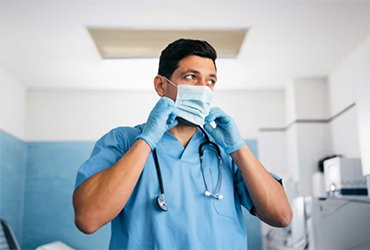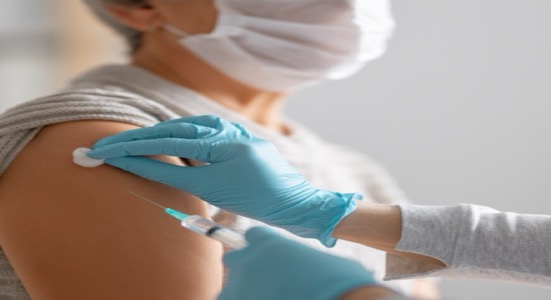By Landon Gray
Wearing surgical masks made no discernible difference in the reduction of hospital-acquired COVID-19 infections, according to new data, which will be shared at the 2023 European Congress of Clinical Microbiology & Infectious Diseases (ECCMID), held in Copenhagen, Denmark.
However, this small study should not be considered the end of the issue, according to George Diaz, MD, FIDSA, the division chief of medicine at Providence Regional Medical Center Everett, in Washington. Previous larger studies have already demonstrated the benefits of masking up.
Researchers analyzed routinely collected infection control data over 40 weeks between Dec. 4, 2021 (the first week of omicron circulation dominance) and Sept. 10, 2022 (the date when universal admission COVID-19 screenings ceased) from St George’s Hospital in London (abstract 5979). They sought to determine how hospital-acquired SARS-CoV-2 infections were linked to changes in mask-wearing policies over time.
All staff and visitors were required to wear masks while in the hospital during phase 1 of the study (Dec. 4, 2021, to June 1, 2022). In the second phase, at week 26 (June 2 to Sept. 10, 2022), most of the wards (the study group) removed the surgical mask–wearing policy. However, a subset of high-risk wards (i.e., renal hematology and oncology wards, the medical admissions unit, and ICUs) kept the mask policy in place for staff (the control group).
The rate of hospital-acquired COVID-19 was adjusted by the infection rate of the underlying community, which was identified through routine admission screening.
In June 2022, during a general community surge in SARS-CoV-2 infections, the researchers found the mask removal policy did not correlate with a statistically significant change in the rate of hospital-acquired COVID-19 in the study group (incidence rate ratio [IRR], 1.11; 95% CI, 0.52-2.33). The infection rate was no higher than the rate when masks were required. The researchers also noted there was no post-intervention identifiable trend to suggest a delayed effect (IRR, 1.01; 95% CI, 0.93-1.10).

They also reported no immediate or delayed change in infection rate among the control group (IRR, 2.56; 95% CI, 0.55-11.81 and IRR, 1.08; 95% CI, 0.92-1.25, respectively).
“Many hospitals have retained masking at significant financial and environment cost, and despite the substantial barrier to communication,” said researcher Aodhan Breathnach, MD, the training program director for the South West Thames Microbiology Training Program and a member of St George’s Research Ethics Committee at the St George’s University Hospitals NHS Foundation Trust, in London. “We hope this empirical evidence can help inform a rational and proportionate mask policy in health services.”
The study had limitations. As an observational study, it could not prove causation, staff mask-wearing adherence was not assessed, and the researchers were unable to determine the infection rates of staff.
“Our study found no evidence that mandatory masking of staff impacts the rate of hospital SARS-CoV-2 infection with the omicron variant,” said lead researcher Ben Patterson, MD, a clinical lecturer at St George’s University Hospitals NHS Foundation Trust. “That doesn’t mean masks are worthless against omicron, but their real-world benefit in isolation appears to be, at best, modest in a healthcare setting.”
Larger studies will need to confirm the study’s findings, according to Dr. Diaz, who was not part of the ECCMID study.
“My concern for this study is that it was too small to detect a signal of benefit, since many other larger studies have demonstrated a benefit to wearing masks to reduce COVID-19 transmission,” Dr. Diaz told Infectious Disease Special Edition.
“I think there is risk that the public will believe that masking is not helpful in healthcare settings, and potentially expose the most vulnerable patients in hospitals to a disease which still causes morbidity and mortality, especially in immunocompromised patients.”
Dr. Diaz reported no relevant financial disclosures.




